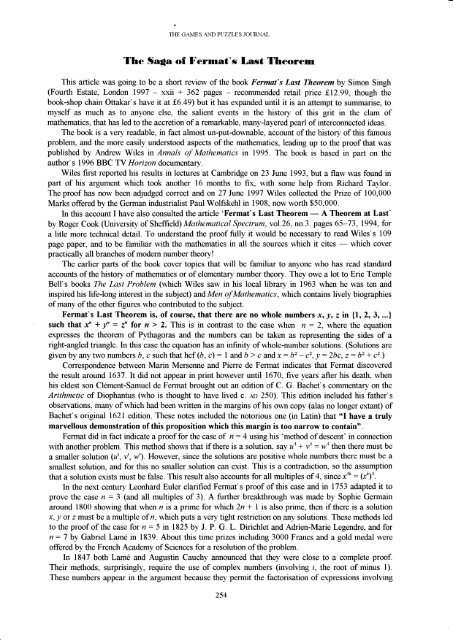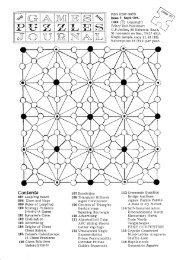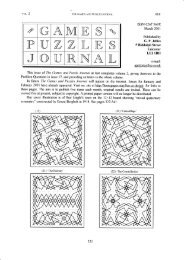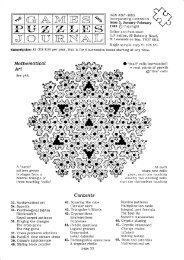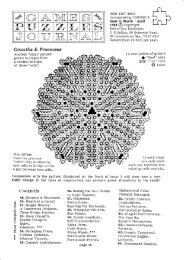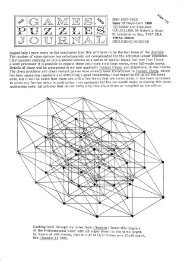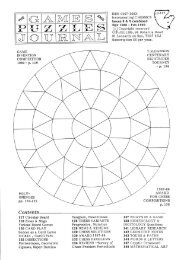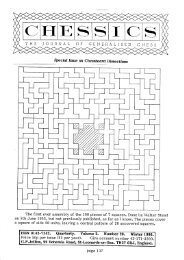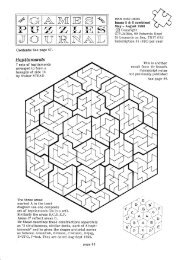The Games and Puzzles Journal, #15 - Mayhematics
The Games and Puzzles Journal, #15 - Mayhematics
The Games and Puzzles Journal, #15 - Mayhematics
You also want an ePaper? Increase the reach of your titles
YUMPU automatically turns print PDFs into web optimized ePapers that Google loves.
o<br />
THE GAh{ES A}.{D PLIZZLES JOLRNAL<br />
<strong>The</strong> Saga of Ferrrrnt's Lact <strong>The</strong>rrrern<br />
This a*icle was going to be a short review of the book Fermat's Last <strong>The</strong>orem by Simon Singh<br />
(Fourth Estate, London 1997 - xxii + 362 pages - recommended retail price f,I2.99, though the<br />
book-shop chain Ottakar's have it at S6.49) but it has exp<strong>and</strong>ed until it is an attempt to summarise, to<br />
myself as much as to anyone else, the salient events in the history of this gnt in the clam of<br />
mathematics, that has led to the accretion of a remarkable, many-layered pearl of interconnected ideas.<br />
<strong>The</strong> book is a very readable, in fact almost un-putdownable, account of the history of this famous<br />
problem, <strong>and</strong> the more easily understood aspects of the mathematics, leading up to the proof that was<br />
published by Andrew Wiles in Annals of Mathemafics in 1995. <strong>The</strong> book is based in part on the<br />
author's 1996 BBC TY Horizon documentary.<br />
Wiles first reported his results in lectures at Cambridge on 23 June 1993, but a flaw was found in<br />
part of his argument which took another 16 months to fix, with some help from Richard Taylor.<br />
<strong>The</strong> proof has now been adjudged correct <strong>and</strong> on 27 h:rae 1997 Wiles collected the Prize of 100,000<br />
Marks offered by the German industrialist Paul Wolfskehl in 1908, now worth $50,000.<br />
ln this account I have also consulted the article 'Fermat's Last <strong>The</strong>orem A <strong>The</strong>orem at Last'<br />
-<br />
by Roger Cook (Universrty of Sheffield) Mathematical Spectrum, vol.26, no.3. pages 65-73, 1994, for<br />
a litle more technical detail. To underst<strong>and</strong> the proof fully it would be necessary to read Wiles's 109<br />
which cover<br />
page paper, <strong>and</strong> to be familiar with the mathematics in all the sources which it cites<br />
-<br />
practically all branches of modern number theory!<br />
<strong>The</strong> earlier parts of the book cover topics ttrat will be familiar to anyone who has read st<strong>and</strong>ard<br />
accounts of the history of mathematics or of elementary number theory. <strong>The</strong>y owe a lot to Eric Temple<br />
Bell's books <strong>The</strong> Isst Problem (which Wiles saw in his local library in 1963 when he was ten <strong>and</strong><br />
inspired his life-long interest in the subject) <strong>and</strong>Men of Mathemafics, which contains lively biographies<br />
of many of the other figures who contributed to the subject.<br />
Fermat's Last <strong>The</strong>orem is, of course, that there are no whole numbers xt !, z in {1, 2, 3r...}<br />
such that t + f = t for n> 2. This is in contrast to the case whe,n fi=2, wherethe equation<br />
expresses the theorem of Pythagoras <strong>and</strong> the numbers can be taken as representing the sides of a<br />
right-angled triangle. In this case the equation has an infinrty of whole-number solutions. (Solutions are<br />
gtven by anytwo numbers D, c suchthat hcf (b, c): I <strong>and</strong> b > c <strong>and</strong>r: b2 - c2,!:2bc, z: b'* c'.\<br />
Correspondence between Marin Mersenne <strong>and</strong> Pierre de Fermat indicates that Fermat discovered<br />
the result around 1637. It did not appear in print however until 1670, five years after his death, when<br />
his eldest son Cldment-Samuel de Fermat brought out an edition of C. G. Bachet's commentary on ilre<br />
Arithmetic of Diophantus (who is thoughtto have lived c. eo 250). This edition included his father's<br />
observations, nuury of which had been written in the margins of his own copy (alas no longer extant) of<br />
Bachet's original 1621 edition. <strong>The</strong>se notes includedthe notorious one (in Latin) that "I have a truly<br />
marvellous demonstration of this proposition which this margin is too narrow to contain".<br />
Fermat did in fact indicate a proof for the case of n = 4 using his 'method of descent' in connection<br />
with another problem. This method shows that if there is a solution, say xf * v4 : wo then there must be<br />
a smaller solution (il', r', w'). However, since the solutions are positive whole numbers there must be a<br />
smallest solution, <strong>and</strong> for this no smaller solution can exist. This is a coltradiction, so the assumption<br />
that a solution exists must be false. This result also accnunts for all multiples of 4, since xou : (fr4.<br />
In the next century Leonhard Euler clarified Fermat's proof of this case <strong>and</strong> in 1753 adapted it to<br />
prove the case n : 3 (<strong>and</strong> all multiples of 3). A further breakthrough was made by Sophie Germain<br />
around 1800 showing that when n is a prime for which 2n + | is also prime, then if there is a solution<br />
x, y or z must be a multiple of n, which puts a very tight restriction or any solutions. <strong>The</strong>se methods led<br />
to the proof of the case for n = 5 in 1825 by J. P. G. L. Dirichlet <strong>and</strong> Adrien-Marie Legendre, <strong>and</strong> for<br />
n = 7 by Gabriel Lame in 1839. About this time prizes including 3000 Francs <strong>and</strong> a gold medal were<br />
offered by the French Academy of Sciences for a resolution of the problem.<br />
In 1847 both Lamd <strong>and</strong> Augustin Cauchy announced that they were close to a complete proof.<br />
<strong>The</strong>ir methods, surprisingly" require the use of complex aumbers (involving i" the root of minus 1).<br />
<strong>The</strong>se numbers appear in the argument because they permit the factorisation of expressions involving<br />
254


